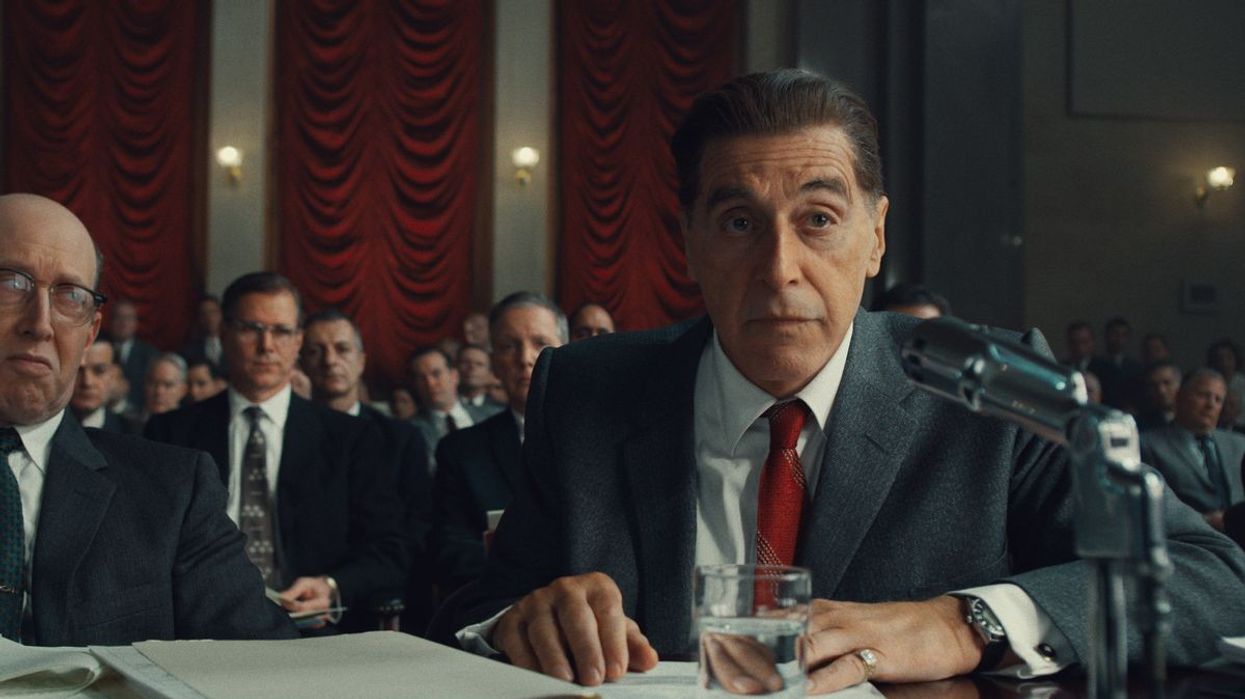You Won't Believe How Scorsese Got 'The Irishman' Made
It's almost time to watch the nearly four-hour epic that is Netflix's The Irishman. But first, go behind the scenes to see how director Martin Scorsese shot this masterpiece.

The Irishman has been in theaters for a month and is set to debut on Netflix November 27. That's tomorrow!
As someone who went opening night, I can't wait to rewatch the movie again and again in the comfort of my own home.
Even more striking than the movie is how it came to be. It took decades of Martin Scorsese pushing and pushing -- at one point, Scorsese and star Robert De Niro turned a greenlight on a similar project into a development deal for The Irishman at Paramount. Crazy.
Recently, The Hollywood Reporter took a deep, deep dive into how this landmark movie for both its director and Netflix came to be.
Behind the Scenes of 'The Irishman' With Martin Scorsese
The Irishman is based on the popular 2004 non-fiction book, I Heard You Paint Houses and it quickly found its way to Scorsese. He wanted to make the movie as soon as he read the book, but his proposed budget of $175 million -- on a period piece -- made studios balk.
That budget was more than what most comic book films or blockbusters cost -- especially for 2004. So, the project sat in development. For awhile.
Eventually, De Niro read the book as research for another part for a Paramount Pictures movie -- Frankie Machine, which would reteam the actor with Scorsese to tell a story about a retired hit man who is called back into the fold. Paramount greenlit Frankie, and while then-Paramount Studios head, the late Brad Grey, was on the phone with De Niro and Scorsese to greenlit Frankie, De Niro pressed paused and talked him, Scorsese, and the studio into a development deal for Houses. Soon after that call, Paramount acquired the book and things were looking good.
But Grey sadly passed away, and the project was stagnant once again.
Then, in 2013, Scorsese thought that the digital effects technology necessary to produce the film -- especially de-age its stars -- was finally at a level where Scorsese could do justice to the movie and make it. He just needed the financial backing.
So, to help get it, Scorsese did what a lot of us do. He held a table read.
This one was populated by stars Robert De Niro, Al Pacino, and Joe Pesci.

The script had been written by Steven Zaillian, who helped co-write Gangs of New York for Scorsese. But instead of the noisy, rock-and-roll visual flare Scorsese loved and previously used on his mob classics Goodfellas and Casino, the director would take a more subdued, workman-like visual approach to the material. For The Irishman was about a blue-collar hero who took his job as seriously and matter-of-fact as a painter does. He was methodical and "okay" with killing. It was just work.
Even if that work made him lose the people around him. And left him with no one. And nothing. Nothing but a lonely room in a musty retirement home.
It marked a significant narrative and visual departure for Scorsese and a new challenge in his life. But he was ready.
And you know who else needed a challenge at the perfect time? Netflix.
The streamer acquired the movie and was on board with Scorsese's vision. According to THR, it was a 108-day shoot that would travel to more than 160 locations. It required the construction of 28 sets, and the production featured 200 characters and a story that hopped through four different time periods.
Sheesh!
The production even embraced the challenge of CG de-aging three actors, all in their late 70s, so they can play younger versions of themselves. But without the typical and cumbersome mo-cap process that Scorsese and his actors feared would get in the way of, or limit, their dynamic and performance.
When asked about why he did not cast younger men to fill those roles, Scorsese said:
"The thing about Bob and Joe and Al is that, playing younger, they're not playing themselves younger, they're playing their characters younger. And what they bring to all that is that they experienced the context of the history and the stories as it was happening, from the '50s, '60s, '70s. That's there in their body language and in their faces. Younger people, it's just really hard. They could maybe do it, but I wouldn't know how to tell them what the significance of Jimmy Hoffa was or the shooting of Joey Gallo. I couldn't really explain. I mean, I could, but they don't get it."

What turned out later was the culmination of Scorsese's vision. At three hours and thirty minutes, The Irishman stands as Scorsese's longest and somehow most expansive movie. It truly earns its epic honors.
Scorsese goes on to say: "It was really a matter of fashioning a pace... Taking a chance on making things run just a hair longer or dwelling on an image just a few frames more."
It's great to see Scorsese bet on himself and Netflix to come in for the rescue.
Netflix gave the film a three-and-a-half-week exclusive theatrical release prior to streaming it. That timing is enough to qualify for awards season and to get everyone talking before it hits the streamer tomorrow.
Says Scorsese:
"Honestly, it's an experiment, as far as I'm concerned. You could see it streamed. You could go see it on a bigger screen. It might be a different experience with an audience. Bottom line is, I just — I'm so happy I got the film made."
What's next? Check out an interview with The Irishman's DP!
Rodrigo Prieto is the cinematographer behind the epic The Irishman. Listen to how he and Scorsese let the story inform their visual shooting style.
















